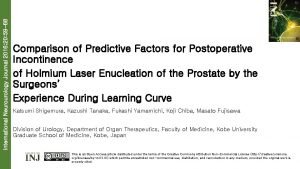International Neurourology Journal 2012 16 181 186 Association





- Slides: 5

International Neurourology Journal 2012; 16: 181 -186 Association of Insulin Resistance with Overactive Bladder in Female Patients Hakki Uzun, Adnan Yilmaz 1, Ahu Kemik 2, Orhan Unal Zorba, Mehmet Kalkan 3 Departments of Urology and 1 Biochemistry, Recep Tayyip Erdogan University School of Medicine, Rize; 2 Department of Biochemistry, Istanbul University Cerrahpasa Medical Faculty, Istanbul; 3 Department of Urology, Fatih University School of Medicine, Istanbul, Turkey This is an Open Access article distributed under the terms of the Creative Commons Attribution Non-Commercial License (http: //creativecommons. org/licenses/by-nc/3. 0/) which permits unrestricted non-commercial use, distribution, and reproduction in any medium, provided the original work is properly cited.

International Neurourology Journal 2012; 16: 181 -186 INTRODUCTION • Metabolic syndrome and obesity have been advocated to be risk factors for the development of overactive bladder (OAB). Additionally, insulin resistance is the underlying mechanism of metabolic syndrome. We aimed to investigate the association of insulin resistance with overactive bladder in female patients. MATERIALS AND METHODS • We prospectively conducted the study in our urology department. Female patients aged between 30 and 76 years old applied to our policlinics with or without OAB symptoms were enrolled. One hundred and twenty-two patients with OAB and 62 age-matched controls without OAB were included into the study. Fasting serum insulin, glucose, high-density lipoprotein (HDL -c), and triglycerides levels were measured. Insulin resistance value was obtained via the homeostasis model assessment of insulin resistance (HOMA-IR) calculator. The chi-square and Mann-Whitney U tests were used to compare differences in variables.

International Neurourology Journal 2012; 16: 181 -186 RESULTS • Serum insulin level was found higher in female patients with OAB (11. 5± 6. 2 μU/m. L) relative to controls (6. 4± 2. 1 μU/ m. L), statistically significant (P=0. 036). In addition, HOMA-IR was significantly found higher in the OAB group, 2. 86 (0. 76 to 17. 04) in comparison to controls, 1. 32 (0. 67 to 224), P=0. 018. High-density lipoprotein cholesterol levels (HDL-c) were significantly found lower in females with OAB. CONCLUSIONS • Insulin resistance can be associated to overactive bladder and may play significant role in pathogenesis.

International Neurourology Journal 2012; 16: 181 -186 Table 1. Demographic and clinical characteristics of patients with and without overactive bladder (OAB)

International Neurourology Journal 2012; 16: 181 -186 Table 2. Laboratory findings of patients with and without overactive bladder (OAB)









